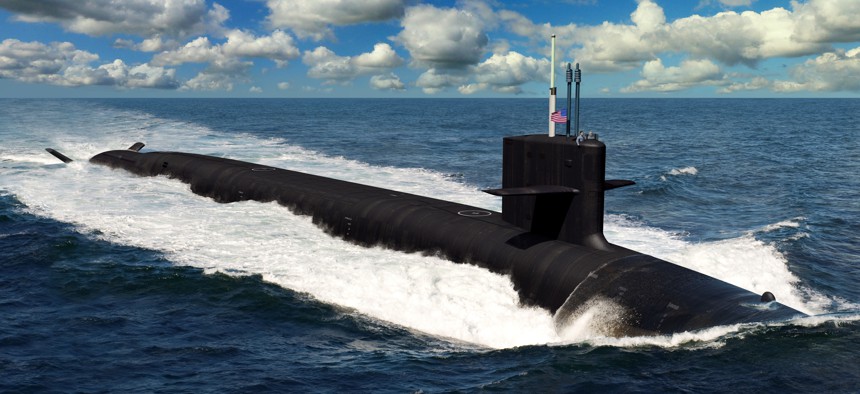
The Biden administration's 2024 budget proposal includes money to upgrade nuclear command-and-control networks and delivery systems such as the under-construction Columbia-class ballistic-missile submarines. Artist's conception / U.S. Navy
Biden’s $842B Pentagon Budget Proposal Would Boost New Weapons
The spending plan also proposes industrial-base investments.
The Biden administration is proposing a $842 billion Pentagon budget for 2024 that boosts spending on new drones, combat jets, hypersonic missiles, and submarines.
That’s up roughly $25 billion—about 3 percent—from the $817 billion appropriated four months ago for the current fiscal year, but the real change will depend on this year’s inflation rate.
The spending plan, announced on Thursday, highlights how Pentagon’s priorities are shifting in response to China’s weapons developments. Pentagon officials are expected to hold briefings about the 2024 spending plan on Monday, when more detailed budget justification documents are sent to Congress.
“The budget prioritizes resources for critical investments enabling the [Defense] Department to continue implementation of the National Defense Strategy, including building the right mix of capabilities to defending against current and future threats,” Defense Secretary Lloyd Austin said in a statement.
In addition to China, which the administration calls the “pacing challenge,” the budget request also takes a number of steps to counter Russia.
“It outlines crucial investments to out-compete China globally and to continue support for Ukraine in the face of unprovoked Russian aggression,” Biden wrote in his “budget message” to Congress.
The budget proposal is sure to face resistance from House Republicans who have criticized the record-high defense spending of recent years and the transfer to Ukraine of billions of dollars in American weapons and aid.
But other Republicans were quick to call the proposed increase too small. Rep. Rob Wittman, R-Va., said in a Thursday statement that the Biden administration proposal “displayed indifference and weakness toward our national security.”
On the Senate side, Sen. Roger Wicker, R-Miss., the top Republican on the Senate Armed Services Committee, called Biden's budget “woefully inadequate and disappointing.”
“It does not even resource his own National Defense Strategy to protect our country from growing threats around the world,” Wicker said in a Thursday statement. “This defense budget is a serious indication of President Biden’s failure to prioritize national security.”
The Democratic leader of the Senate Armed Services Committee took a middle line.
“Some will inevitably say the topline is too much, while others will claim it is not enough,” Sen. Jack Reed, D-R.I. said in a statement. “I say America’s defense budget should be guided by our values, needs, and national security strategy.”
Over the past two years, Congress has added tens of billions of dollars to Biden’s defense spending request in response to record-high inflation and support to replenish weapons given to Ukraine.
If lawmakers continue that trend, “The result will be the highest military budget since World War II, far higher than at the peaks of the Korean or Vietnam Wars or the height of the Cold War, said William Hartung, senior research fellow at the Progressive Quincy Institute for Responsible Statecraft. “This enormous sum is far more than is needed to provide an effective defense of the United States and its allies.”
Biden’s budget request “in key technologies and sectors of the U.S. industrial base such as microelectronics, submarine construction, munitions production, and biomanufacturing,” the document states. A fragile U.S. supply chain exacerbated by the pandemic has caused numerous problems for weapons manufacturers.
“[T]he Budget modernizes and expands the production capacity of the industrial base to ensure the Army can meet strategic demands for critical munitions,” the document states.
Munitions factories have been stressed as the U.S. allies need to replenish stocks of weapons given to Ukraine over the past year.
“[T]he U.S. aerospace and defense industry relies on the administration’s budget request as a roadmap for investments in innovative technology, a resilient supply chain, and a vibrant workforce,” said Eric Fanning, CEO of the Aerospace Industries Association, a trade group that represents large and small defense contractors. “We need strong investment to meet the Administration’s National Defense Strategy, address inflation, and build up key munitions and production lines — not only to maintain our own stockpiles but also to support our allies and partners.”
Earlier this week, Air Force Secretary Frank Kendall said the budget proposal would call for boosting production of warplanes.
“Investing in this mix of aircraft provides an opportunity to increase the resiliency and flexibility of the fleet to meet future threats, while reducing operating costs,” the document states.
For the Navy, the administration said it is proposing “executable and responsible investments” in the fleet.
“[T]he Budget makes meaningful investments in improving the lethality and survivability of the fleet, particularly improving undersea superiority,” the document says.
The spending plan also calls for increased spending on ‘the development and testing of hypersonic strike capabilities while enhancing existing long-range strike capabilities to bolster deterrence and improve survivability.”
It also includes funds for “ongoing nuclear modernization programs” including new nuclear command, control, and communications networks needed to transmit launch codes between new intercontinental ballistic missiles, stealth bombers, and submarines.
The spending plan includes $9.1 billion for the Pacific Deterrence Initiative, efforts being taken to bolster the U.S. infrastructure in response to China. It also includes $6 billion to counter Russia through support for Ukraine and NATO allies.







